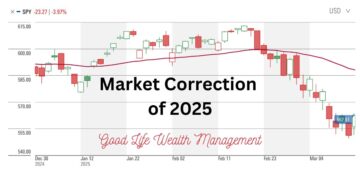Successful investing is as much about managing our personal tendencies and behaviors as it is about picking funds. You don’t have to be a financial whiz to be a thriving investor, but you do have to avoid making mistakes. Investing errors do not mark you as a novice or as unintelligent; even professionals can easily fall into these traps. Mistakes are easier to see in hindsight, but in the present moment, the choices we face may not be so obvious.
Here are what I consider to be the Seven Deadly Sins of Investing. I firmly believe that if we can avoid these errors, we will have a much higher chance of success as long-term investors.
1. Not Accepting Losses (Pride)
If you’ve made a losing investment, sell it and move on. Too many investors are unwilling to do this, hoping that if they wait long enough, they will be proven correct or at least get their money back. Unfortunately, this may not occur, and even if it does, there may be an opportunity cost in waiting. With today’s strong markets, you might not have losses, but if you have high-expense funds that are under-performing the market, you should recognize that this too is a mistake and move on.
2. Market Timing (Greed)
Speculating to make as much profit as possible and trying to avoid temporary market drops drives many people to move in and out of the market in a largely futile attempt to improve returns. Neither individual investors nor professionals have demonstrated any success in market timing, although great time and effort are spent in the process. The reality is that market returns are a good return, but when investors say “I want more, I need more”, they are very often rewarded with lower returns rather than higher returns.
3. No Asset Allocation (Lust)
Did you pick the funds for your 401(k) by selecting the options with the best one-year performance? If so, you likely will end up with a poor investment plan, because you are investing based solely on past performance. Don’t fall in love with today’s hot funds, those are the ones that will break your heart at the next downturn, when you discover how much risk they were taking. At any given point in time, one or two categories may dominate returns, fooling investors to think that owning 10 different technology funds makes you diversified. Start with a globally diversified asset allocation and then pick funds that represent each category. Yes, even buy those segments which are out of favor and under-performing today. That’s how you build a better portfolio.
4. Performance Chasing (Envy)
With thousands of mutual funds and ETFs at our disposal, it takes only a few clicks to find a “better performing” fund than the ones currently in your portfolio. There are hundreds of funds which have outperformed their benchmark over the past year. Of course, that number will fall dramatically over time, and typically 80% or more of funds fail to match their benchmark over five or more years. But even still, that means some funds have beaten the index. Unfortunately, there is no predictive power in past returns of actively managed funds, so even those that beat the mark over the last five years are unlikely to continue their streak over the next five years.
Perhaps even more dangerous is when investors “discover” that a sector or country is outperforming. Maybe it’s a technology fund, or Argentina ETF, which has rocketed up in the past six months, and they switch from a diversified fund to a narrow investment. Performance chasing creates a lot of risk which may go unnoticed until it’s too late. We avoid single sector and country funds; almost every argument for these funds is some version of performance chasing.
5. Single Security Risk (Gluttony)
Most of the heart-breaking investing stories I’ve heard from the past 20 years were caused by investors having a large investment in a single company. The 55-year old Nortel employee who had his whole retirement account in his company stock and rode it down from $1 million to $100,000. The Cisco employee who exercised $600,000 in stock options, but kept the shares to try for long-term capital gains; the shares tanked, and he didn’t know he would owe AMT on the original $600,000. The IRS had a lien on his house while he paid them $200,000 over five years.
Diversification is the only free lunch in investing. The average stock will return about the same as the index by definition, but you take on tremendous risk when you have a concentrated position in one stock. The best choice is to not have too much in any one stock, including that of your employer.
6. Breaking Your Plan (Wrath)
Anger, frustration, and despair were what investors felt in 2008 and 2009, and we will undoubtedly feel the same way when the next bear market occurs. Some investors threw in the towel near the bottom and missed out on much of the rebound. The best way to prevent future frustration is to make sure you have the right asset allocation and understand how your portfolio might perform in up and down years. When you begin with a smart plan and take the time to educate yourself, it is much easier to understand the importance of staying invested rather than allowing emotions to get the best of us.
7. Failing to Monitor (Sloth)
Even for passive investors, you still need to do some work monitoring and managing your portfolio on a regular basis. Rebalancing annually or when funds move a large amount is important to maintain your target risk levels and to create a process to “buy low and sell high”. Additionally, too many investors have stayed with poorly performing active funds and variable annuities they don’t understand, paying high expense ratios, unnecessary 12-b1 fees and sales loads, without having any idea about how they are doing. You only have three or four decades of work and investing, you can’t let 5 or 10 years go by without knowing if your plans are on track. It’s your money, surely you can spend a handful of hours every quarter to analyze your situation and make changes when they are needed.
Successful investing is not complicated, but it can be difficult to have the patience with how boring it can be most of the time and how unpredictable it can be other times. Establish a diversified asset allocation that will help you achieve your long-term goals, then invest in low-cost, tax-efficient vehicles with a good track record. Focus on what you can control: your allocation, costs, and diversification, and don’t worry about the short-term movements of the market.
We all face the temptation of these seven investing sins. Maybe the greatest attribute for an investor is faith. Do what is right, do what is smart, but then to let go of the worry about what will happen today or tomorrow. Market returns will be whatever the market returns. We have no control over the market, but we can focus on our own saving (frugality), patience, and positive thoughts. In the end, the true measure of wealth is more about our faith and gratitude than it is about the dollars and cents.







